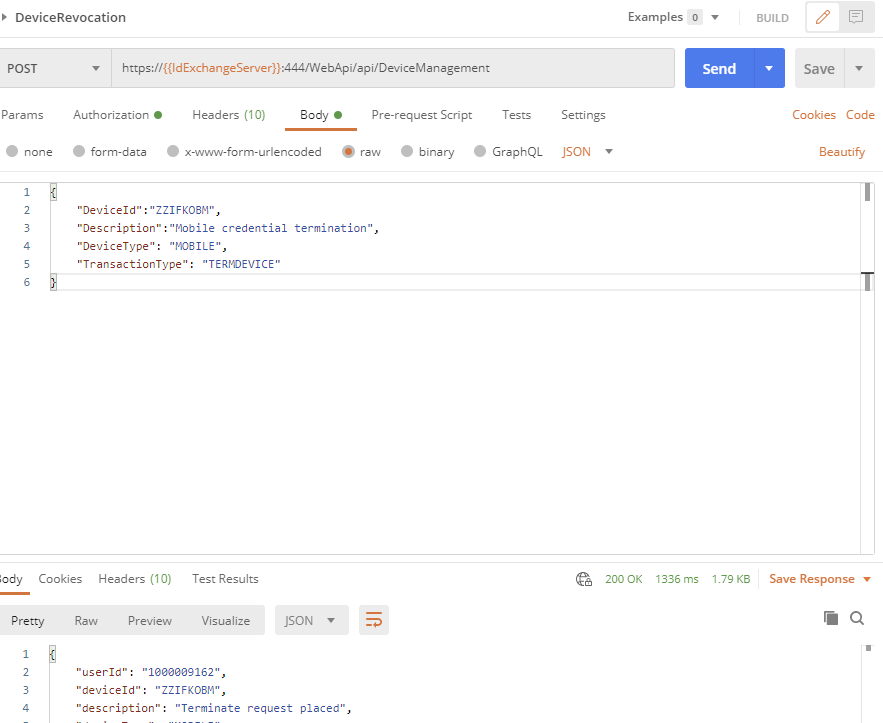Mobile Credentialing API
This tutorial describes how to use the IdExchange API to generate a mobile credential for a device. The {{IdExchangeServer}} placeholder should be replaced with id.cyberarmed.com
Tools:
In this example, the Postman tool can be used to provide an example of how the API calls are structured. However, any code platform capable of making REST calls will work.
Authentication
The API requires a digital certificate for authentication. When the certificate is verified, the API will return a Java Web Token (JWT) that can be used for subsequent calls.
API Endpoint: https://{{IdExchangeServer}}:444/WebApi/Token
Body: grant_type=password
Response:
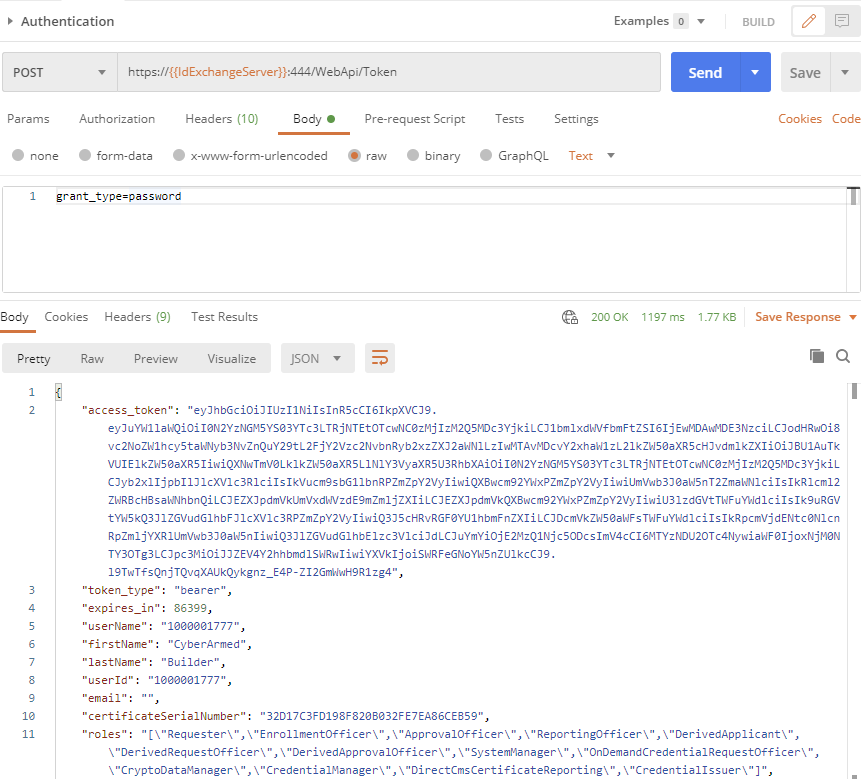
Mobile Credential Creation
Step 1: User Registration
The user must be provisioned to the IDMS so that devices can be linked to the user. In the first step, the base user information and PIV Authentication is sent in.
API Endpoint: https://{{IdExchangeServer}}:444/WebApi/api/Requests
Parameters:
Parameter | Description |
|---|---|
userId | The user ID from the originating directory. For example, if using Active Directory, this is typically the samAccountName. |
lastName | Last name of the user |
firstName | First name of the user |
emailAddress | Email address of the user |
dob | Date of birth. For this value, use “NR” |
hasSupplementalDocuments | Indicates the user will have further credentials to process. Set this value to: SETTOREQUESTED |
userCredentialKey | The IDMS credential policy that will be used for identity proofing and credential generation. |
externalIdSource | The friendly name of the originating directory. |
PivAuthenticationCertificate | The base 64 PIV certificate from the user’s PIV card. |
Sample JSON:
{
"userId": "MobCred77470740",
"lastName": "MobileLast",
"firstName": "MobileFirst",
"emailAddress": "tuser@cyberarmed.onmicrosoft.com",
"dob": "NR",
"hasSupplementalDocuments": "SETTOREQUESTED",
"userCredentialKey": "IDNTI",
"externalIdSource":"IDMS Applicant Resource",
"PivAuthenticationCertificate":"BASE_64_ENCODED_CERTIFICATE_FROM_PIV_CARD"
}
If successful, the call will return with a 10 digital ID (see screenshot below). Save this ID for later steps.
Step 1.A: User Attribute Registration
User organization information can be added to provide additional identity proofing and credential customization. For example, organization structure information, additional contact information and other information relevant to describe the user’s business relationship with the organization.
API Endpoint: https://{{IdExchangeServer}}:444/WebApi/api/UpdateUserSupplementalAttributes
Parameters
Parameter | Description |
|---|---|
userId | The IDMS user ID that was returned in step 1. |
AttributeType | Describes the type of supplemental information be submitted. use the value: |
AttributeValue | A base64 encoded string of the additional information to be sent in. The .net example below shows the structure of the data and the encoding type for the conversion. string json = string b64Value = Convert.ToBase64String(System.Text.ASCIIEncoding.ASCII.GetBytes(json)); |
FileName | The filename that will be associated. Use the value |
| The type of data to be sent in. Use the value: json |
Filesize | The size of the data to be sent in Use the value: json ( so the value is auto calculated) |
Sample JSON:
{
"UserId": "1000009166",
"AttributeType": "USERSUPPLEMENTATTR",
"AttributeValue": "W3siZGF0YU5hbWUiOiAidXNlcnByaW5jaXBhbG5hbWUiLCJkYXRhVmFsdWUiOiAiTWVzdExhc3Q5NzM4NjYwNUB0ZXN0bW9iaWxlLmxvY2FsIiwidGV4dCI6IG51bGx9LHsiZGF0YU5hbWUiOiAib3JnYW5pemF0aW9uYWxVbml0IiwiZGF0YVZhbHVlIjogIkxBTkwiLCJ0ZXh0IjogbnVsbH0seyJkYXRhTmFtZSI6ICJvcmdhbml6YXRpb25hbFVuaXQyIiwiZGF0YVZhbHVlIjogIk9MVFBLSSIsInRleHQiOiBudWxsfSx7ImRhdGFOYW1lIjogIm9yZ2FuaXphdGlvbmFsVW5pdDMiLCJkYXRhVmFsdWUiOiAiVS5TLiBHb3Zlcm5tZW50IiwidGV4dCI6IG51bGx9LHsiZGF0YU5hbWUiOiAiY291bnRyeSIsImRhdGFWYWx1ZSI6ICJVUyIsInRleHQiOiBudWxsfSx7ImRhdGFOYW1lIjogInNhbWFjY291bnRuYW1lIiwiZGF0YVZhbHVlIjogIk1vYkNyZWQ5NzM4NjYwNSIsInRleHQiOiBudWxsfV0=",
"FileName": "SupplementalData",
"FileType": "json",
"FileSize": "json"
}
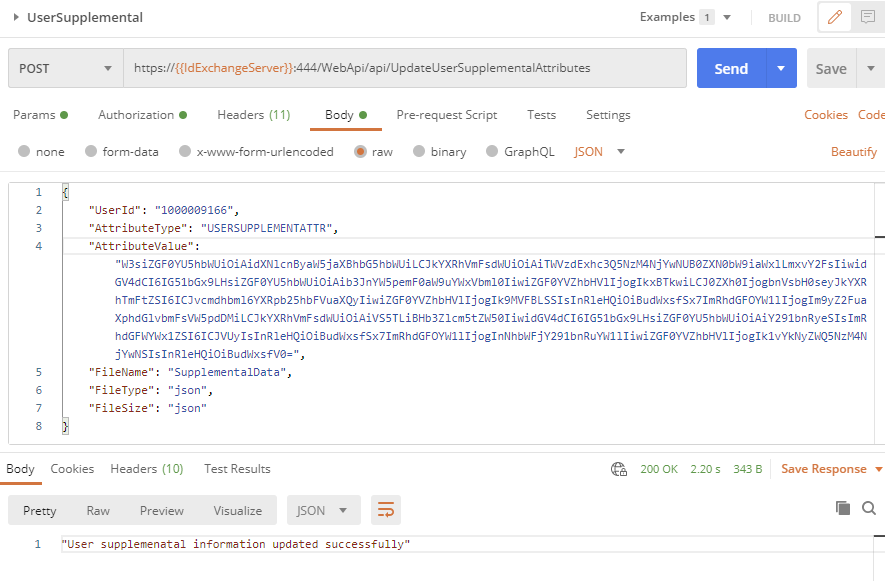
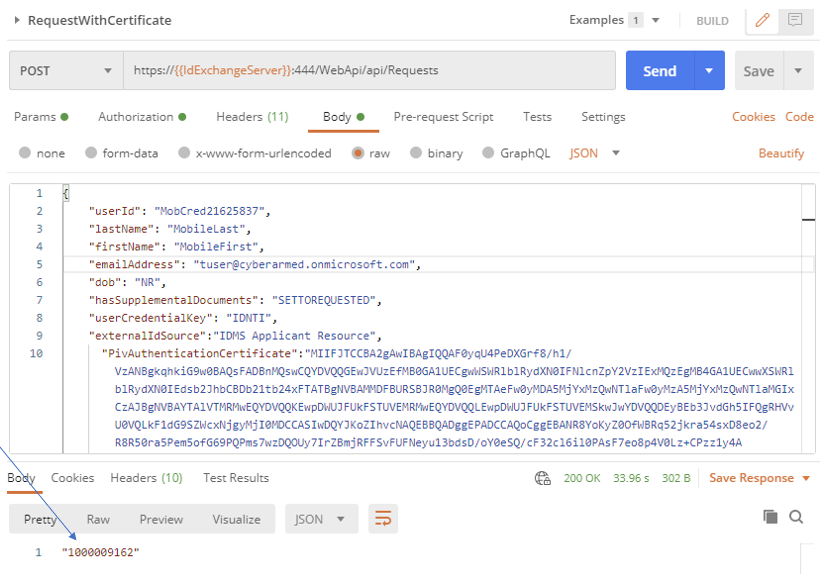
Step 2: Add User Biographic Data
The IDMS supports PIV identity proofing workflows that support biometric capture. The next step will be submit the user’s photo, fingerprints, documents and other biometric information required by the credential policy. Even if there is no biometric data to be submitted, this API must be called with empty biometrics in order to enable the user to qualify to receive a credential.
API Endpoint: https://{{IdExchangeServer}}:444/WebApi/api/BioSubmission2
Parameters:
Parameter | Description |
|---|---|
Photo | The photo of the user. If no photo, just use ““ |
TransactionType | The insert mode for the user. In this case, use AUTOINS |
userID | The user ID from the originating directory. For example, if using Active Directory, this is typically the samAccountName. |
externalIdSource | The friendly name of the originating directory. |
UserCredentialPolicyKey | The IDMS credential policy that will be used for identity proofing and credential generation. |
Sample JSON:
{
"Photo":"",
"TransactionType":"AUTOINS",
"userId": "MobCred21625837",
"externalIdSource":"IDMS Applicant Resource",
"UserCredentialPolicyKey":"IDNTI"
}
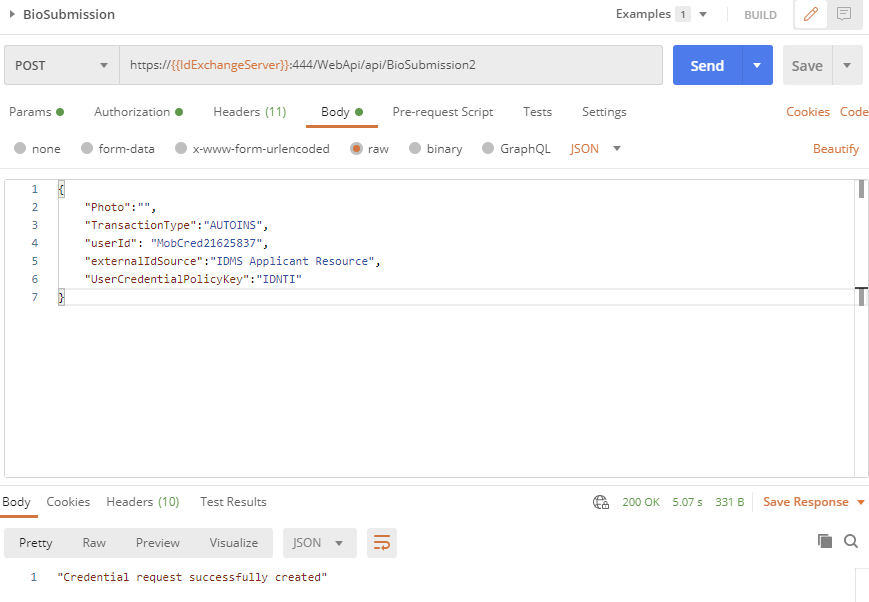
Step 3: Register user’s device.
In this phase, device information will be registered and linked to the user. The device unique ID, description, device management system and device type will be sent. Additionally, the user id from step 1 will be sent in order to associated the device with the user.
API Endpoint: https://{{IdExchangeServer}}:444/WebApi/api/DeviceInsert
Parameters:
Parameter | Description |
|---|---|
DeviceId | The unique value for a given device. |
Description | A description of the device |
DeviceManagementSystem | If managed by MDM, the Friendly name of the MDM. |
DeviceType | The type of device. |
TransactionType | The processing step to take for the given device. “DEVICEADD” will add a new device to a given user. |
UserId | The IDMS user ID that was returned in step 1. |
Sample JSON:
{
"Description":"Blackberry",
"DeviceId":"ZZIFKOAN",
"DeviceManagementSystem":"Blackberry",
"DeviceType": "MOBILE",
"TransactionType": "DEVICEADD",
"UserId":"1000009162"
}
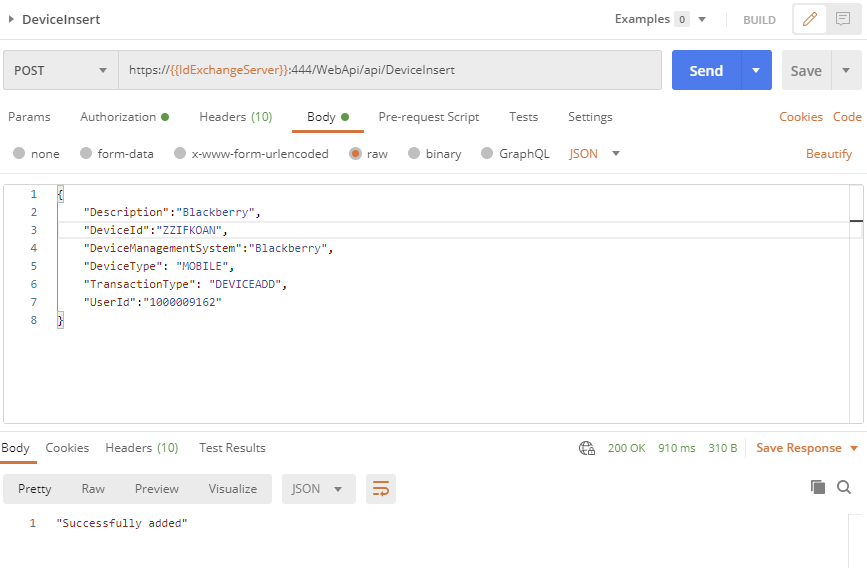
Step 4: Approve the user’s device
To provide multi-person control, the device registration and approval phase is separated into two calls to enable one person to register, and another person to verify. When the device is verified, a temporary registration code will be returned. This temporary registration code will be used in the certificate retrieval phase to further verify the request.
API Endpoint: https://{{IdExchangeServer}}:444/WebApi/api/DeviceManagement
Parameters
Parameter | Description |
|---|---|
DeviceId | The unique value for a given device. |
Description | A description of the device. |
DeviceManagementSystem | If managed by MDM, the Friendly name of the MDM. |
DeviceType | The type of device. |
TransactionType | The processing step to take for the given device. “VERIFY” will verify a given device to enable to retrieve a certificate.. |
UserId | The IDMS user ID that was returned in step 1. |
CertificateAuthorityForCredentialing | The IDMS friendly name of the certificate authority that will sign the certificate signing request. |
Sample JSON:
{
"deviceId":"ZZIFKOAN",
"TransactionType":"VERIFY",
"userId":"1000009162",
"DeviceManagementSystem":"Blackberry",
"DeviceType":"Blackberry",
"Description":"Blackberry",
"CertificateAuthorityForCredentialing":"MicrosoftCA"
}
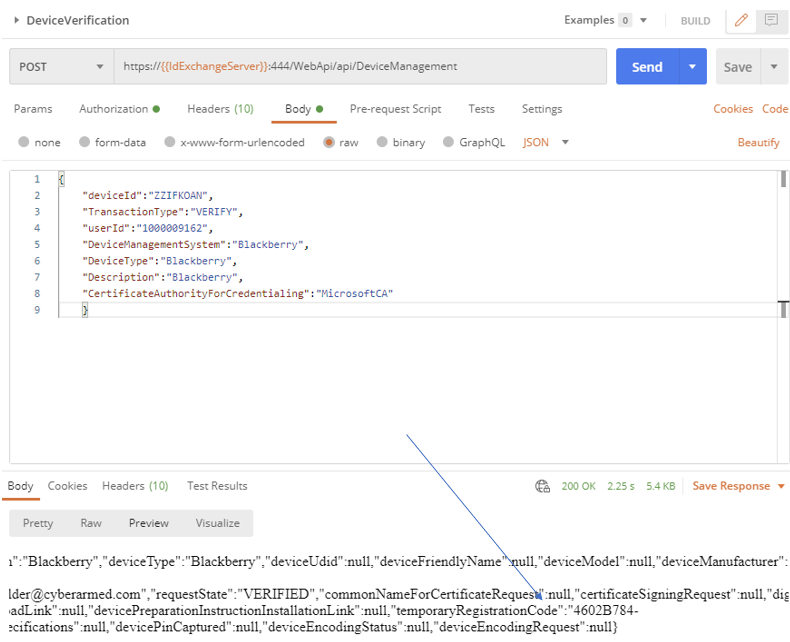
Step 5: Retrieve certificate for device
After the device has been approved, the certificate and be issued.
API Endpoint: https://{{IdExchangeServer}}:444/WebApi/api/DeviceManagement
Parameters:
Parameter | Description |
|---|---|
DeviceId | The unique value for a given device. |
Description | A description of the device. |
DeviceType | The type of device. |
TransactionType | The processing step to take for the given device. “REQCERTIFICATE” will request a certificate for a given device. |
CertificateAuthorityForCredentialing | An optional field that can override the certificate authority previously specified. Use the ““ to use the pre-specified CA. |
CertificateSigningRequest | The PKCS10 certificate signing request from the mobile device. |
DeviceManagementSystem | If managed by MDM, the Friendly name of the MDM. |
TemporaryRegistrationCode | The temporary code that was received during the verification phase to authenticate the certificate request for a given device. |
CredentialRequestSpecifications "CommonName":"IDMS": This enables the common name in the CSR to be overridden. To do this, supply “IDMS” as the value so that the naming information from IDMS will be taken to create the common name. "DeviceId":"IDMS": This enables the Device ID to be placed into the certificate subject name. To do this, supply “IDMS” as the value so that the device information from the IDMS will be used to create the serial number. "OrganizationalUnitPath": This is a string literal what will used to format the details of the certificate. The value should conform with X.509 and will be placed within the certificate. An example is: C = US, O = U.S. Government, OU = TEST, OU = TEST | If the certificate request needs to be customized or override some of the CSR settings, values can be sent it via the CredentialRequestSpecifications object. |
Sample JSON (no certificate subject customization. only the CSR will be used to create certificate)
{
"DeviceId":"ZZIFKOAN",
"Description":"Mobile credential request",
"DeviceType": "MOBILE",
"TransactionType": "REQCERTIFICATE",
"CertificateAuthorityForCredentialing": "",
"CertificateSigningRequest": "BASE_64_PKCS10_CSR",
"DeviceManagementSystem": "Blackberry",
"TemporaryRegistrationCode":"F2148746-B"
}
Sample JSON (with certificate subject customization)
{
"DeviceId":"ZZIFKOAN",
"Description":"Mobile credential request",
"DeviceType": "MOBILE",
"TransactionType": "REQCERTIFICATE",
"CertificateAuthorityForCredentialing": "",
"CertificateSigningRequest": "BASE_64_PKCS10_CSR",
"DeviceManagementSystem": "Blackberry",
"TemporaryRegistrationCode":"F2148746-B",
"credentialRequestSpecifications": {
"CommonName":"IDMS",
"DeviceId":"IDMS",
"OrganizationalUnitPath": "C = US, O = U.S. Government, OU = TEST, OU = TEST"
}
}
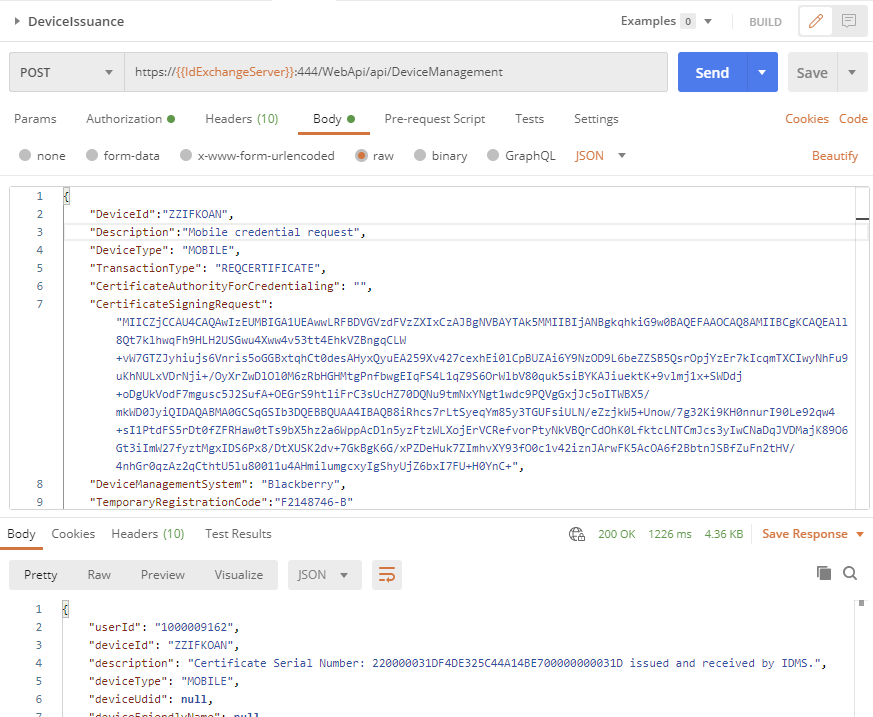
Revoking a device
To revoke the certificate that was retrieved for the certificate, the “TERMDEVICE” transaction type is required.
Parameter | Description |
|---|---|
DeviceId | The unique value for a given device. |
Description | A description of the device. |
DeviceType | The type of device. |
TransactionType | The processing step to take for the given device. “ |
Sample JSON:
{
"DeviceId":"ZZIFKOBM",
"Description":"Mobile credential termination",
"DeviceType": "MOBILE",
"TransactionType": "TERMDEVICE"
}
